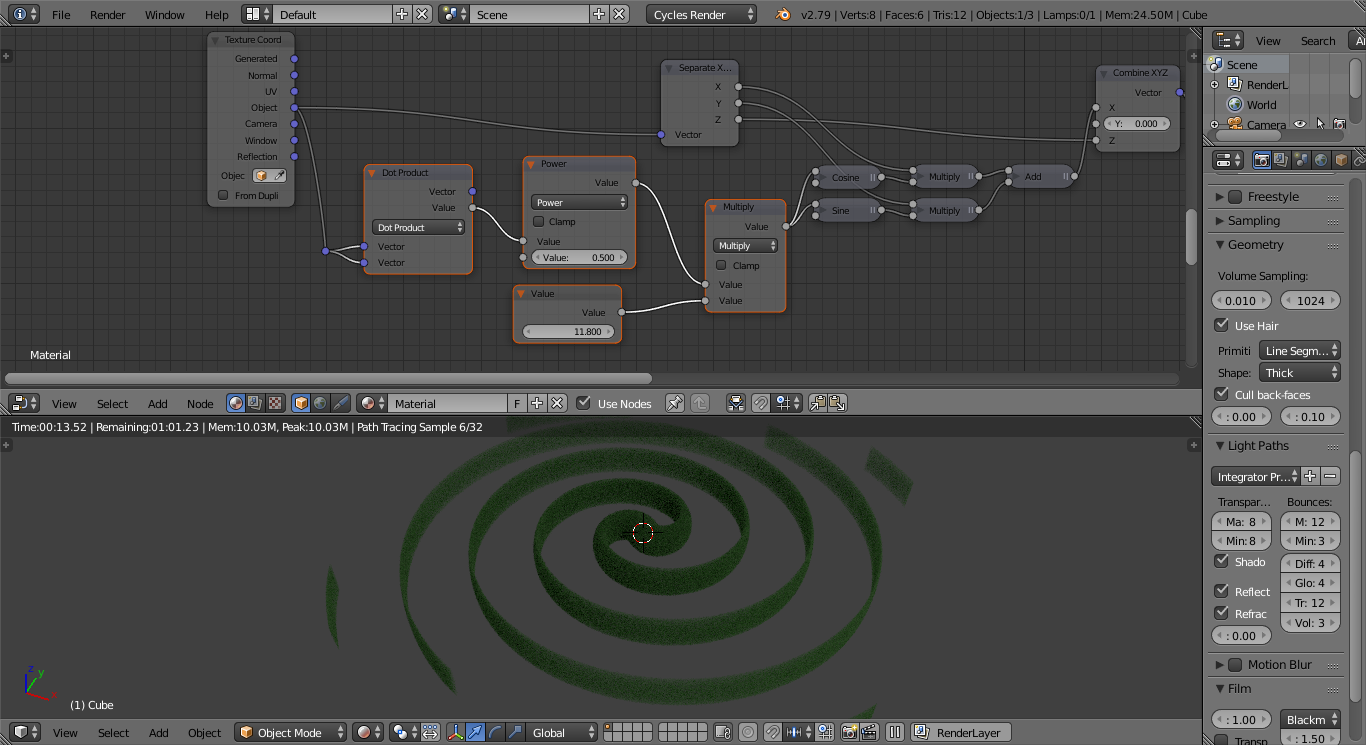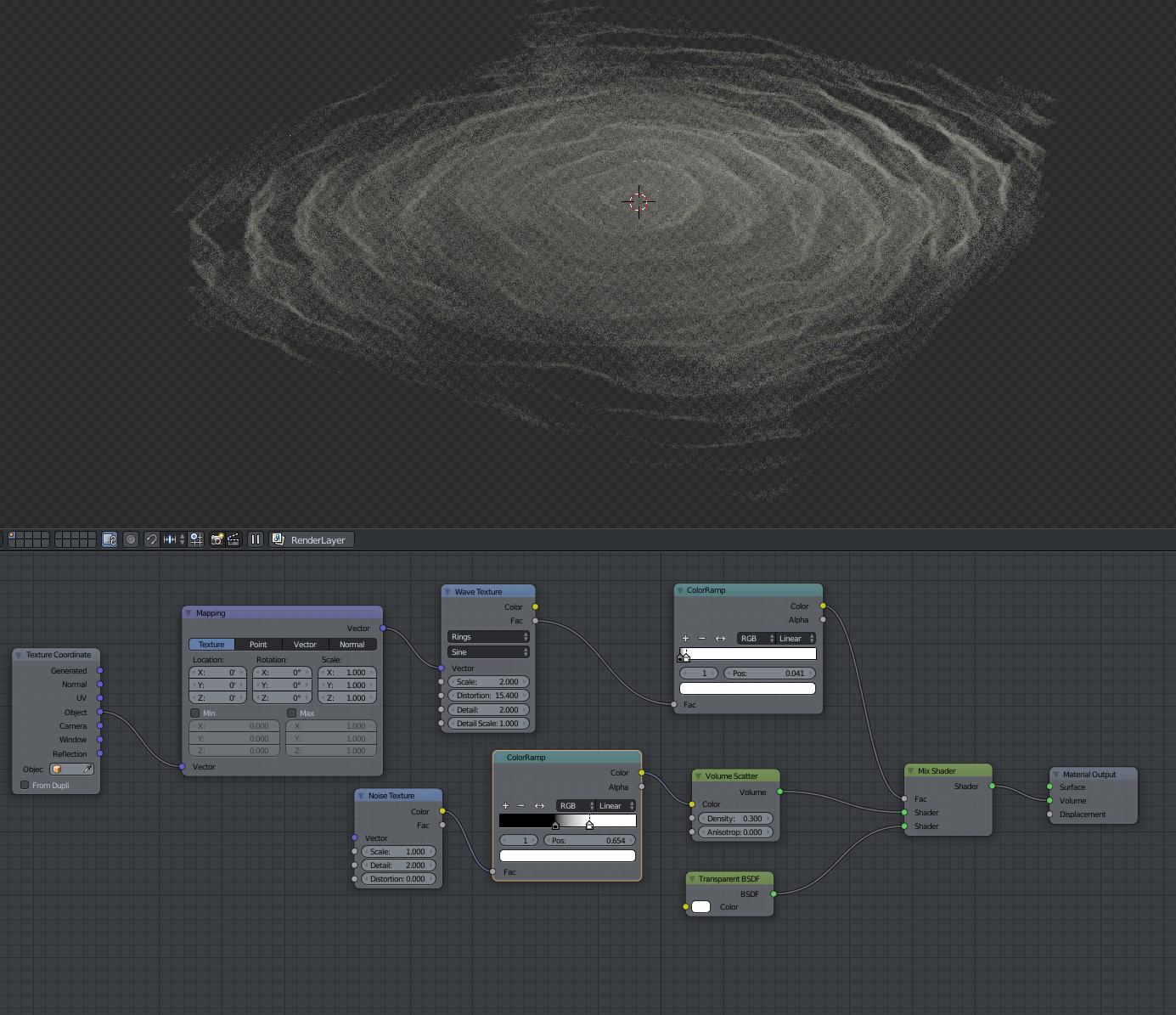I'm trying to make a galaxy in blender. If I use an image of a galaxy to get the spiral shape it becomes a 2d image projected into the 3d volume. To avoid this I wanted to use a procedural method, but I can't figure our how to get a spiral shape. I've tried searching this and I don't get any results similar to what I'm looking for
-
$\begingroup$ You would like to create a 3D texture to drive the density of a volume shader? Could you specify your current workflow? $\endgroup$– CarloCommented May 2, 2018 at 22:06
-
$\begingroup$ @Carlo I don't have any workflow at the moment, I'm just trying to make a spiral shaped procedural pattern, I will eventually use it to drive a volume shader, yes. $\endgroup$– SudoadminCommented May 2, 2018 at 22:11
-
$\begingroup$ So we are talking about "nodes", right? I ask becuse there are many other ways to create a spiral for faking a galaxy. $\endgroup$– CarloCommented May 2, 2018 at 22:17
-
$\begingroup$ @Carlo yes nodes cycles preferably $\endgroup$– SudoadminCommented May 2, 2018 at 22:18
-
1$\begingroup$ Maybe this can help: blender.stackexchange.com/q/78379/36012 $\endgroup$– yannCommented May 2, 2018 at 23:39
2 Answers
One method is to create a volumetric cylinder and distort it by rotating it around the origin by an amount that varies based on the distance from the origin.
First, create a volumetric cylinder. This is achieved by calculating the distance from the origin in just two of the three dimensions (it's effectively a circle projected along the remaining axis). This can be achieved using the Dot Product vector maths node using the following arrangement (assuming the cylinder is to be produced along the 'y' axis) :
The Dot Product used in this way (with the same vector on both inputs) produces the square of the length of the vector. The following Power(0.5) node calculates the square root of the squared length - ie, the actual vector length. The Less Than node controls the radius of the cylinder.
NOTE : The Geometry Volume Sampling step size has been decreased to 0.010 in this example in order to improve the volumetric precision (at the expense of render time). Also, the Light Paths Volume Bounces has been increased from zero to 3 to allow multiple scatter bounces (see the properties panel at the right-hand side of the image).
In order to rotate the cylinder we need to use a rotation matrix similar to
X = x * cos(angle) + y * sin(angle)
Y = -x * sin(angle) + y * cos(angle)
Since we already know that the 'y' coordinate is irrelevant (since the cylinder is unchanged regardless of where along the y-axis it is viewed) we can simplify this by only actually needing to calculate in the X coordinate. This is therefore achieved with the following additional nodes :
NOTE : Varying the Value input node rotates the volumetric cylinder. The Multiply node multiplies the input value by 2*pi, converting the input value to radians - so 0.0 to 1.0 produces one whole rotation.
To produce a spiral we can simply vary the rotation based on the distance from the origin. This can be achieved with another Dot Product/Power node combination with the following additional nodes :
Increasing the Value input varies the number of turns of the spiral.
Note, however, that the spiral is stretched into a thin ribbon as it is rotated. To counteract this we can simply add additional nodes to vary the thickness of the original "cylinder" based on the distance from the origin :
Thickness controls how much the cylinder is scaled based on the distance and Bias controls the starting thickness at the centre of the spiral (prevents it collapsing down to a point).
Note that this is a very much "brute force" method of generating a spiral - and it can only produce a spiral with two "arms" (unless you were to truncate the spiral at y = 0 - in which case it would have a single "arm").
Another approach is to generate the spiral directly - rather than distorting a cylinder - by calculating for each 'sample point' the closest point that lies on the centreline of the spiral. Calculating the distance to the centreline of the spiral allows us to determine whether that point lies within the spiral. This produces more versatile results and does not require manual adjusting of the thickness. It can also generate spirals with any number of 'arms'.
To achieve this we need to be able to calculate the closest point on the centreline of the spiral. For any point in the volume we can determine a number of things about this 'closest point'
- It lies on the 'plane' of the spiral - in our case we can use
z = 0 - The sample point in the volume is along the direction of the Normal of the centreline from the closest point - ie, it points away from or towards the origin.
- The centreline distance from the origin varies based on the angle that the spiral centreline makes in the plane of the spiral (and, therefore, also its normal).
This allows us to calculate the closest point of the centreline for any point in the volume. Once we know the 'closest point' we can simply calculate the distance between it and the sample point to determine whether that point in the volume lies inside or outside the spiral (based on our desired "arm" radius).
Firstly, the angle to the origin - this can be calculated using standard trigonometry using the arctangent, since tan(angle) = x / y so atan(x / y) = angle. This will only give a result over half the rotation before repeating for the other half, so we need to include additional nodes to add 180 degrees (or 'pi' radians) for the second half of the rotation - ie, when the sign of the y-coordinate flips between positive and negative. This yeilds the following nodes to determine the angle from the coordinates :
The distance from the origin can be determined simply using the Dot Product and a Power(0.5) maths node (again, passing the same vector into both inputs of the Dot Product calculates the square of the distance, the power(0.5) takes the square root, resulting in the actual length of the vector) :
The modulo function is used to determine which rotation around the spiral arm is the closest to this point and this, adjusted based on the angle (calculated as above) gives us the point on the spiral that is closest to this sample point in the volume.
We can add in some nodes to allow the results to be adjusted (eg, varying the thickness based on the distance so that it thins out towards the ends of the arms) and this produces the following material :
To make it easier to reuse, we can create a node group that takes the vector in the volume, the desired properties of the spiral (number of "arms", "twistedness") :
This can be used as follows :
Now you have a configurable volumetric spiral, the only remaining challenge is to use this to produce a believable galaxy :
To make each galaxy different we can use the Object Info 'Random' property to generate the spiral properties to produce the following result :
-
1$\begingroup$ Ok fine, you win, I guess its better than mine. lol ** off to Kahn Academy to learn some math** One day I will understand what the heck you are doing. Good Job! $\endgroup$– icYou520Commented May 9, 2018 at 22:05
This is the closest I can get to a spiral with only nodes.
I am sure there is some math functions that could help but that is out of my realm.
I just use a wave texture to form the rings and had the mix shader mix in transparency with another wave texture. Its not exactly a spiral but maybe it can help.
I didn't try, but maybe you can add a 2nd mapping node and offset one of the wave textures and see if it "cancels" out some of the rings that make it look like more of a spiral. Just a guess.
-
1$\begingroup$ I think it might actually just be a limitation of the current build. I've been searching for a while and cant find anything. Thank you for trying, that is way better than anything I've made. $\endgroup$ Commented May 2, 2018 at 23:36
















